Study on the Two-Step Construction Method of Super Large Cross-Section Tunnels Crossing Karst Cave Areas
Abstract
1. Introduction
2. Overview of Related Supporting Projects
3. Stability Analysis of Step Method of Construction
3.1. Calculation Parameters
3.2. Calculation Conditions
3.3. Construction Steps
- (1)
- Excavating the upper step, the excavation height is 6 m, and the excavation footage is 1 m.
- (2)
- The initial support is carried out on the upper step excavated in step 1. The construction of the supporting structure lags the excavation of the upper step by 1 m and the length of the supporting structure is 1 m.
- (3)
- Excavating the lower step, the excavation height of the lower step is 4.3 m, the excavation lags the upper step by 6 m, and the excavation footage is 1 m.
- (4)
- The initial support is carried out on the lower step, the lag excavation is 1 m, and the support length is 1 m.
- (5)
- The inverted arch is excavated at 12 m behind the lower step, and one-time excavation is completed with a length of 6 m.
- (6)
- Initial support for inverted arch construction.
3.4. The Variation Law of Surrounding Rock Deformation with Surrounding Rock Grade
3.5. Characteristics of Rock Deformation and Failure
- (1)
- With the progress of the excavation, the displacement of each monitoring point gradually increases, the deformation gradually develops from the arch to the wall foot, and the deformation gradually decreases according to the order of the arch, the arch waist, the arch foot, the sidewall, and the wall foot.
- (2)
- Tunnels with poor surrounding rock (IV-grade-preferred surrounding rock and V-grade surrounding rock) mainly suffer from instability of the supporting structure, large extrusion deformation of the tunnel face, and local small-scale falling blocks. The tunnel with poor surrounding rock (poor V-grade surrounding rock) will have instability of the tunnel face. The surrounding rock will collapse 4.5 m in front of the tunnel face and 1.5 m above the arch. The deformation and failure will develop from the arch to the foot of the wall, and the influence distance of excavation will be approximately 20 m.
4. Stability Control Measures for Step Method Construction and Analysis of Design Parameters
4.1. Calculation Conditions
- (1)
- When ω is 3.8, the deformation of the rock surrounding the tunnel under the pre-support of the advanced large pipe shed is analyzed, and the effectiveness of the advanced large pipe shed measures on the V-grade surrounding rock of the super large cross-section tunnel is verified.
- (2)
- The stability of the surrounding rock is compared and analyzed when the reinforcement range of the pipe roof is 120°, 150°, and 180°, and the reinforcement length of the pipe roof is 15 m, 20 m, 25 m, and 30 m, respectively.
- (3)
- The stability of the surrounding rock is compared and analyzed when the cyclic footage is 0.5 m, 1.0 m, and 1.5 m (the step length is 6.0 m, and the step height is 6.0 m), the step length is 4.0 m, 6.0 m, and 8.0 m (the cyclic footage is 1.0 m, and the step height is 6.0 m), and the step height is 4.0 m, 5.0 m, and 6.0 m (the cyclic footage is 1.0 m, and the step length is 6.0 m).
4.2. Effect Analysis of Advanced Large Pipe Shed
- (1)
- With the excavation process, the displacement of each monitoring point gradually increases with excavation, the deformation gradually develops from the arch foot to the wall foot (shown in 1~3 of Figure 5), and the deformation decreases in the order of arch foot, side wall, wall foot, arch waist, and arch. The total displacement is 181.2 mm, 175.0 mm, 146.5 mm, 133.3 mm, and 127.4 mm, respectively.
- (2)
- The failure area of the surrounding rock in the tunnel arch is much smaller. With the advancement of the excavation face to a deeper depth, the surrounding rock failure area mainly develops below the arch. The failure law is from the arch foot to the sidewall and, finally, to the wall foot.
4.3. Analysis of the Pipe Roof Design Parameters
- (1)
- When the reinforcement range of the pipe roof increases from 90° to 180°, the arch settlement, horizontal convergence, and tunnel face displacement are significantly reduced, and the decreases are −59.4%, −52.0%, and −25.6%, respectively. The maximum displacement position of the surrounding rock around the tunnel gradually shifts from the arch foot to the sidewall and, finally, to the wall foot. The deformation of the supporting structure is also significantly reduced, which indicates that the pipe roof also reduces the deformation of the supporting structure by reducing the advanced deformation. From the perspective of displacement reduction caused by unit angle, it is more economical to adopt a reinforcement range of 120° for controlling the arch settlement and the displacement of the tunnel face, and a reinforcement range of 150° for controlling the convergence displacement is more economical.
- (2)
- The length of the pipe shed increases from 15 m to 30 m. Compared with 15 m, when the length of the pipe shed is 20 m, the advanced deformation of the surrounding rock, the settlement of the arch of the supporting structure, and the displacement of the tunnel face are significantly reduced, and the reductions are −15.5%, −24.1%, and −32.3%, respectively. Compared with the pipe shed lengths of 30 m and 20 m, the displacement of the pipe shed is basically unchanged, with a decrease of approximately 1% to 6%.
4.4. Analysis of Step Design Parameters
- (1)
- The adjustment of the circulation footage z mainly affects the settlement of the arch of the supporting structure. Compared with z = 0.5 m, when z is 1.5 m, the advanced deformation increases from 45 mm to 50 mm, the settlement of the arch of the supporting structure DV increases from 58 mm to 90 mm, and the deformation of the tunnel face DF increases from 137 mm to 161 mm, an increase of approximately 14.9%.
- (2)
- Adjusting the step length l mainly affects the settlement of the arch of the supporting structure. Compared with l = 4 m, when l is 8 m, the advanced deformation of the peripheral convergence increases from 42 mm to 60 mm, an increase of approximately 42.8%, and the deformation of the tunnel face DF decreases from 157 mm to 134 mm, a decrease of approximately −15.7%. The arch settlement of the supporting structure DV increased from 47 mm to 93 mm, an increase of approximately 97.8%.
- (3)
- Adjusting the step height h mainly affects the surrounding convergence of the supporting structure. Compared with h = 4 m, when h is 8 m, the surrounding convergence of the supporting structure DH increases from 20 mm to 61 mm, an increase of approximately 205%. The extrusion deformation of the tunnel face DF increased from 126 mm to 145 mm, an increase of approximately 15.1%.
5. Two-Step Method for Constructing a Super Large Cross-Section Tunnel in Karst Cave Development Stratum
5.1. Calculation Conditions
5.2. Construction Process
- (1)
- Advanced geological prediction and sketching of the tunnel face are carried out on the tunnel face to confirm the grade of the surrounding rock and the condition of the surrounding rock in front.
- (2)
- The karst development is judged according to the surrounding rock conditions, and the advanced support measures and design parameters are determined according to the surrounding rock grade and karst cave development.
- (3)
- The hole-forming and charging operations are carried out in the upper and lower steps. The upper and lower steps are blasted at the same time, and the excavation is carried out in parallel. The design parameters of the steps should meet the requirements of large-scale mechanical operation space under the condition of ensuring the stability of the surrounding rock.
- (4)
- The fan is opened to discharge the dust in the hole, and the excavator is used to carry out the dangerous rock discharge under excavation treatment around the hole. The excavator cooperates with the mucking truck to carry out the mucking operation. After the dust is discharged, geological sketching is carried out on the face of the tunnel. According to the results of the geological sketch, the karst cave treatment and the initial support construction are carried out.
- (5)
- According to the geological sketch results, the advanced support measures and design parameters of the next cycle and the design parameters of the steps are adjusted.
6. Engineering Applications
6.1. V-Grade Surrounding Rock Step Method Construction
- (1)
- The geological radar is used to detect the range of 30 m in front of the tunnel face in the ZK1 + 382 section. The arch line map shows that the radar wave reflection is strong in the 9~15 m section in front of the tunnel face, which may develop large-scale karst caves, groundwater is not developed, and the surrounding rock level is V-grade.
- (2)
- According to the conditions of the surrounding rock and the development of the karst cave, the advanced support adopts the advanced large pipe shed. The design length of the advanced large pipe shed is 20 m, and the circumferential reinforcement arch is 120°. A total of 31 holes were arranged. Through the analysis of the drilling records of the pipe shed, the 11~18 m section of 8~14 holes are filled with karst cave, so the length of 8~14 holes is extended to 22 m. The layout of the advanced large pipe shed is shown in Figure 8.
- (3)
- The upper steps and lower steps are excavated in parallel. The length of the step is 4 m, the height of the step is 5 m, and the cyclic footage is the spacing of 2 steel frames.
- (4)
- After the ventilation and mucking operation, the geological sketch results show that the 3 m × 3 m × 5 m (length, width, height) semi-filled silty clay karst cave is exposed on the left sidewall of the lower step, and the primary support is closed after cleaning the filling and concrete backfilling. The tunnel face is relatively stable, there is no obvious extrusion deformation, and there is a small amount of falling blocks. The initial support adopts HW200 × 200H steel, a 3.5 m-long φ42 mm grouting steel pipe lock foot, C20 thick 29 cm early strength shotcrete, and a 5.0 m-long φ22 mm cartridge bolt.
6.2. IV-Grade Surrounding Rock Bench Method Construction
- (1)
- In the range of 30 m in front of the tunnel face, the geological radar is used for detection. The arch line map shows that there is a strong radar reflection section in the 3~9 m section in front of the tunnel face, so it is speculated that there is a large-scale cavity in this section. The sidewall survey line map shows that there is a strong radar reflection section in the front 2~5 m section, so it is speculated that there may be a weak interlayer or cavity in this section. The surrounding rock is IV-grade.
- (2)
- According to the condition of the surrounding rock and the development of the karst cave, it is judged that the advanced support adopts φ42 advanced small pipe and φ76 partition advanced large pipe shed. The design length of the advanced small pipe is 4.5 m, the circumferential spacing is 40 cm, the extrapolation angle is 10°, the arch is 120°, and the lap length is greater than 1.0 m. The preliminary determination range of the partition advanced large pipe roof layout is 30° on the left side of the arch. Then, according to the analysis of the pipe roof drilling records, the 4–11 m section of 10–15 holes is determined as the filling karst cave. The final partition advanced large pipe roof layout scheme is 10–15 holes with a length of 15 m. The partition advanced large pipe roof layout is shown in Figure 10.
- (3)
- The length of the step is 5 m, the height of the step is 5 m, and the cyclic footage is two steel frames. The upper steps and lower steps are excavated in parallel.
- (4)
- After the ventilation and mucking operation, the geological sketch results show that the tunnel face is unstable, the extrusion deformation of the tunnel face is obvious, and there is a local collapse phenomenon. The tunnel face is closed by 20 cm-thick shotcrete. The initial support adopted I20 b I-shaped steel, a 3.5 m-long φ42 mm grouting steel pipe locking foot, C20 thick 25 cm early strength shotcrete, 4.0 m long φ22 mm cartridge anchor rods. The 2 m × 2 cm × 3 cm (length, width, height) semi-filled silty clay karst cave was exposed on the left arch foot of the upper step, and the primary support was closed after cleaning the filling and concrete backfilling.
- (5)
- According to the exposed conditions of the karst cave and the state of the tunnel face, the length and height of the next cycle step are adjusted according to the longitudinal and vertical ranges of the karst cave. The adjusted step length can be greater than 5 m, and the step height should be less than or equal to 6 m. In the next cycle, the leading small pipe is adjusted to a φ42 double-layer length of 6.0 m, circumferential spacing of 40 cm, extrapolation angle of 10°, and arch range of 120°.
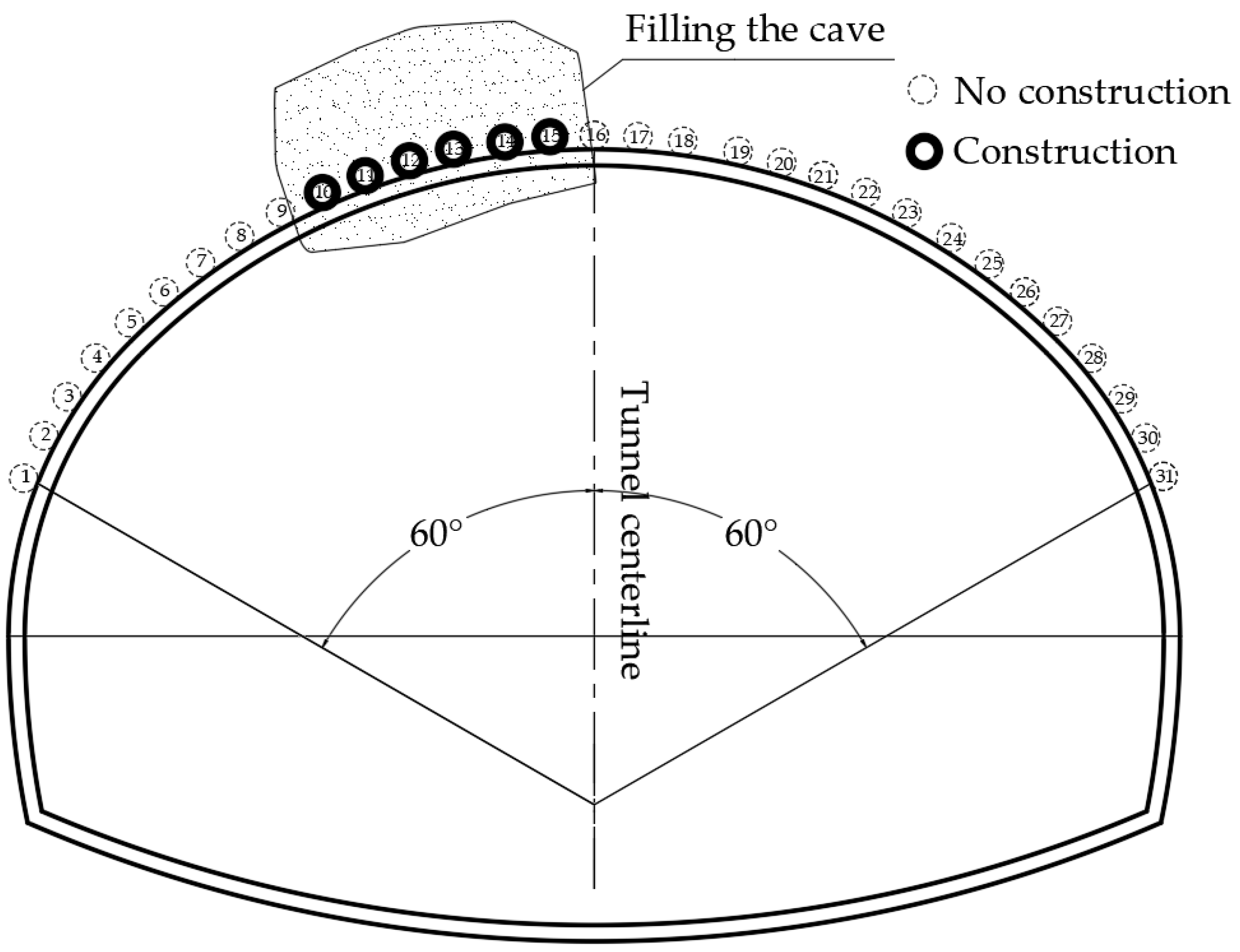
7. Conclusions
- (1)
- When the advanced small pipe measures are adopted, the tunnel face can be self-stabilized during the construction of the IV-grade surrounding rock of the super-large cross-section tunnel by the two-step method. However, the tunnel face of the V-grade surrounding rock section of the super large cross-section tunnel is easily unstable. The surrounding rock in the range of about 4.5 m in front of the tunnel face and about 1.5 m above the arch has collapsed, and the advanced influence distance is approximately 20 m. The countermeasures should be mainly based on the tunnel face for stability control.
- (2)
- The adoption of advanced large pipe shed measures can significantly improve the construction stability of the two-step method in the V-grade surrounding rock section of the super large cross-section tunnel. The reasonable design parameters of the advanced large pipe shed can improve the economy and construction speed of the measures. A reinforcement range of 120° is more economical for controlling the arch settlement and the displacement of the tunnel face, and a reinforcement range of 150° is more economical for controlling the convergence displacement. The deformation control effect is the best when the pipe shed length is 20 m. Shortening the step cycle footage can significantly reduce the arch settlement of the supporting structure. Reducing the step length can significantly reduce the arch settlement of the supporting structure but increase the extrusion deformation of the tunnel face. Reducing the step height can significantly reduce the surrounding convergence of the supporting structure.
- (3)
- The stability of the surrounding rock and karst cave should be controlled at the same time during the construction of the super large cross-section tunnel crossing the IV-grade and V-grade surrounding rock section in a karst cave area. According to the conditions of the surrounding rock and the development of karst caves, advanced support measures and two-step excavation should be adopted according to the classification. Among them, the IV-grade surrounding rock adopts the advanced small pipe to control the stability of the surrounding rock, and the arch and large-scale filling karst cave are treated in advance by partition advanced pipe shed measures. The V-grade surrounding rock adopts an advanced large pipe roof to control the stability of the surrounding rock and karst cave. After the excavation of the micro-step, the primary support is quickly closed to control the deformation of the support, and the exposed karst cave is treated by measures such as closure and concrete backfilling.
Author Contributions
Funding
Institutional Review Board Statement
Informed Consent Statement
Data Availability Statement
Acknowledgments
Conflicts of Interest
References
- Wu, S.; Li, L.; Ren, G.; Xia, C.; Wang, X. Study on Comparison and Selection of Excavation Method for Tunnel with Super Large Section and Shallow Buried Broken Surrounding Rock. Chin. J. Undergr. Space Eng. 2023, 19, 794–803. [Google Scholar]
- Luo, Y.; Shi, Z.; Chen, J.; Liu, W.; Chen, L.; Li, Y.; Wu, Y. Mechanical Calculation Model and Research on Construction Mechanical Behavior of Middle Diaphragm in Upper Bench CD Method for Super-large Span Tunnel. China J. Highw. Transp. 2020, 33, 235–248. [Google Scholar] [CrossRef]
- Hou, F.; Sun, K.; Zhao, R.; Zhou, H.; Xu, W.; Zhou, Z. Applicability study on construction method of super-large section neighborhood tunnel. China Civ. Eng. J. 2017, 50, 111–116. [Google Scholar]
- Zhang, J.; Wu, J.; Yan, C.; Gou, X.; Ye, L.; Feng, J. Construction Technology of Super Large Section of Highway Tunnels with Four or More Lanes in China. China J. Highw. Transp. 2020, 33, 14–31. [Google Scholar] [CrossRef]
- Zhou, J.; Zou, G.; Peng, H. Construction Method for Large Section Deep-buried Rail Transit Stations: Bench Cut Method with Expanded Arch Feet. Urban Rapid Rail Transit 2023, 36, 117–123. [Google Scholar]
- Cui, L.; Zheng, J.; Zhang, R.; Yu, S. Analysis of deformation of the surrounding rock and preliminary Support stress in tunnels through weak and cracked strata. J. Huazhong Univ. Sci. Technol. Nat. Sci. Ed. 2012, 40, 53–57. [Google Scholar]
- JTG/T 3660-2020; Technical Specifications for Construction of Highway Tunnel. China First Highway Engineering Co., Ltd.: Beijing, China, 2020.
- Song, S.; Li, S.; Li, L.; Liu, Q.; Yuan, X.; Shi, S. Study on Rules of Mechanical Effect in Process of Construction of Super-large Cross-section Tunnel in Weak and Broken Surrounding Rock Excavated by Bench Method. Tunn. Constr. 2011, 31, 170–175. [Google Scholar]
- Zou, C.; Shen, Y.; Jin, Z. Study of Bench Method’s Geometric Parameters Optimization in Weak Broken Wall Rock and Large Cross-section Tunnel. Highw. Eng. 2013, 38, 27–31+35. [Google Scholar]
- Wu, J.; Chen, J.; Ma, J.; Song, Y.; Zhou, C.; Guo, S.; Sun, Y. Design and Fast Construction Technology for Large-Cross-Section Tunnel in Water-Rich Fracture Zone. Tunn. Constr. 2022, 42, 353–359. [Google Scholar]
- Li, W.; Sun, M.; Zhu, Y.; Zhu, Z.; Li, Y. Arch springing stability and its control techniques during construction of tunnels with weak surrounding rocks by bench cut method. Chin. J. Rock Mech. Eng. 2012, 31, 2729. [Google Scholar]
- Luo, Y.; Chen, J. Mechanical characteristics and mechanical calculation model of tunnel feet-lock bolt in weak surrounding rock. Chin. J. Geotech. Eng. 2013, 35, 1519. [Google Scholar]
- Zou, Y. Study on Stability of Tunnel Face and Optimization of Advance Support Parameters in Soft Rock Tunnel by Large Cross-Section Construction. Master’s Thesis, Guangxi University, Nanning, China, 2023. [Google Scholar]
- Yuan, X. Study on Construction Process Optimization of Ultra-large Section Tunnel with Soft and Fractured Surrounding Rock and Its Application. Master’s Thesis, Shandong University, Jinan, China, 2012. [Google Scholar]
- Liu, L.; Zheng, Y.; Zhang, Z. Numerical Simulation Study on Influence of Existing Top Karst Cave on Stability of Tunnel Surrounding Rock. Mod. Tunn. Technol. 2023, 60, 86–95. [Google Scholar]
- Zhang, G.; Ye, S.; Zeng, B.; Zhao, K. Influence of Concealed Cave Group in Fault Zone on Stress Characteristics of Tunnel Lining and Comparison of Construction Methods. Mod. Tunn. Technol. 2023, 60, 65–73. [Google Scholar]
- Li, K.; Duan, Z.; Guo, D.; Zeng, B.; Wang, Q. Study on Influence of Different Azimuth Angles of Concealed Karst Cave on the Stress Characteristics of Tunnel Lining Structure. Mod. Tunn. Technol. 2023, 60, 74–85. [Google Scholar]
- Xu, H.; Geng, H.; Li, C.; Chen, W.; Wang, C. Estimating strength of grouting reinforced bodies in broken rock mass. Chin. J. Geotech. Eng. 2013, 35, 2018–2022. [Google Scholar]
- Zheng, Y.; Qiu, C.; Zhang, H.; Wang, Q. Exploration of stability analysis methods for surrounding rocks of soil tunnel. Chin. J. Rock Mech. Eng. 2008, 27, 1968–1980. [Google Scholar]
- Wang, B. Analysis of the development law of karst in Lianhuashan Tunnel. Highway 2019, 64, 226–230. [Google Scholar]
- Wan, F. A Method for Detecting and Treating Large Karst Caves in Advance in Tunneling. Chinese Patent No. ZL2019113212631, 30 March 2021. [Google Scholar]
- Li, L.; Wang, B.; Fu, Z.; Wang, F. Experimental study on selection of advanced pipe shed in Lianhuashan Tunnel. China Foreign Highw. 2022, 42, 179–182. [Google Scholar]

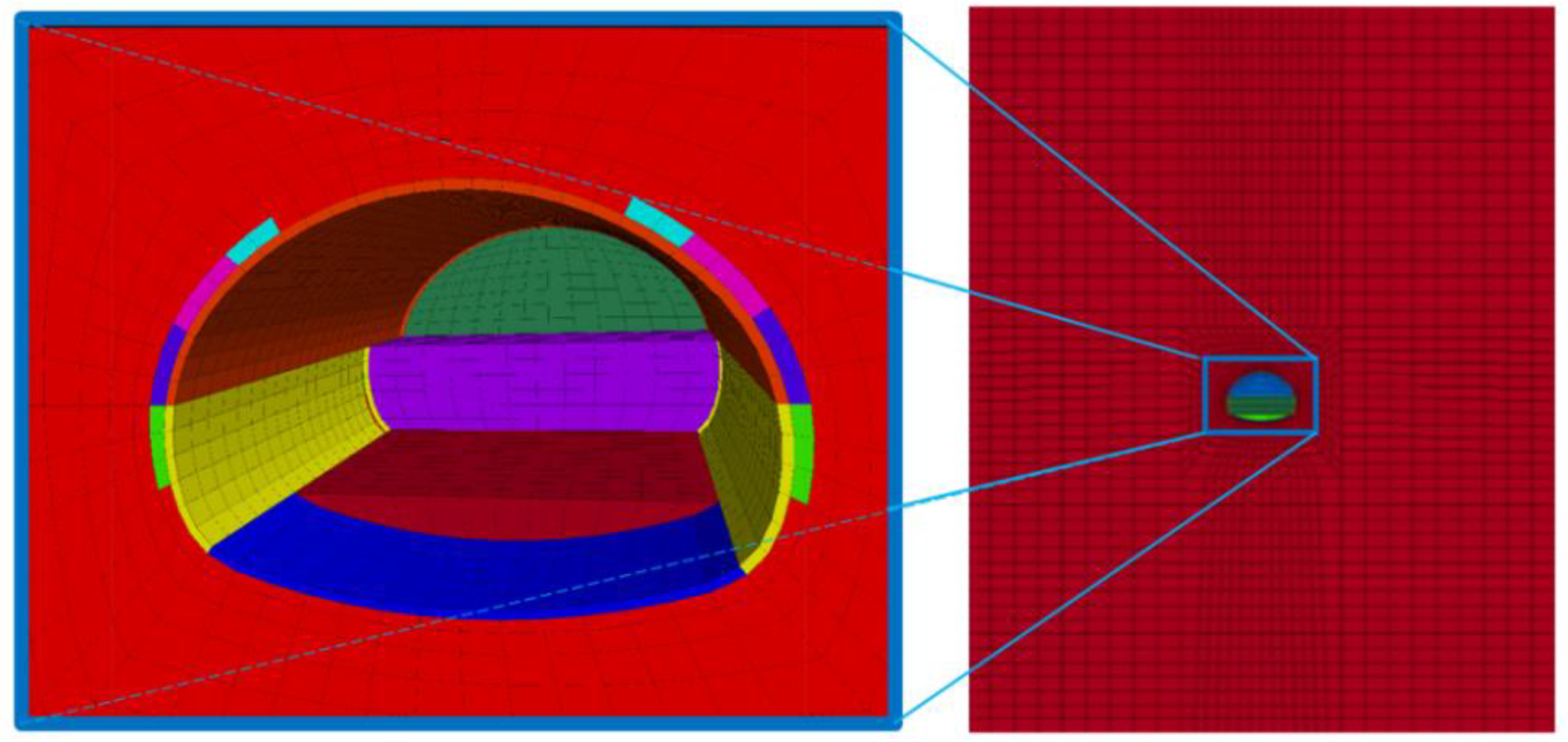
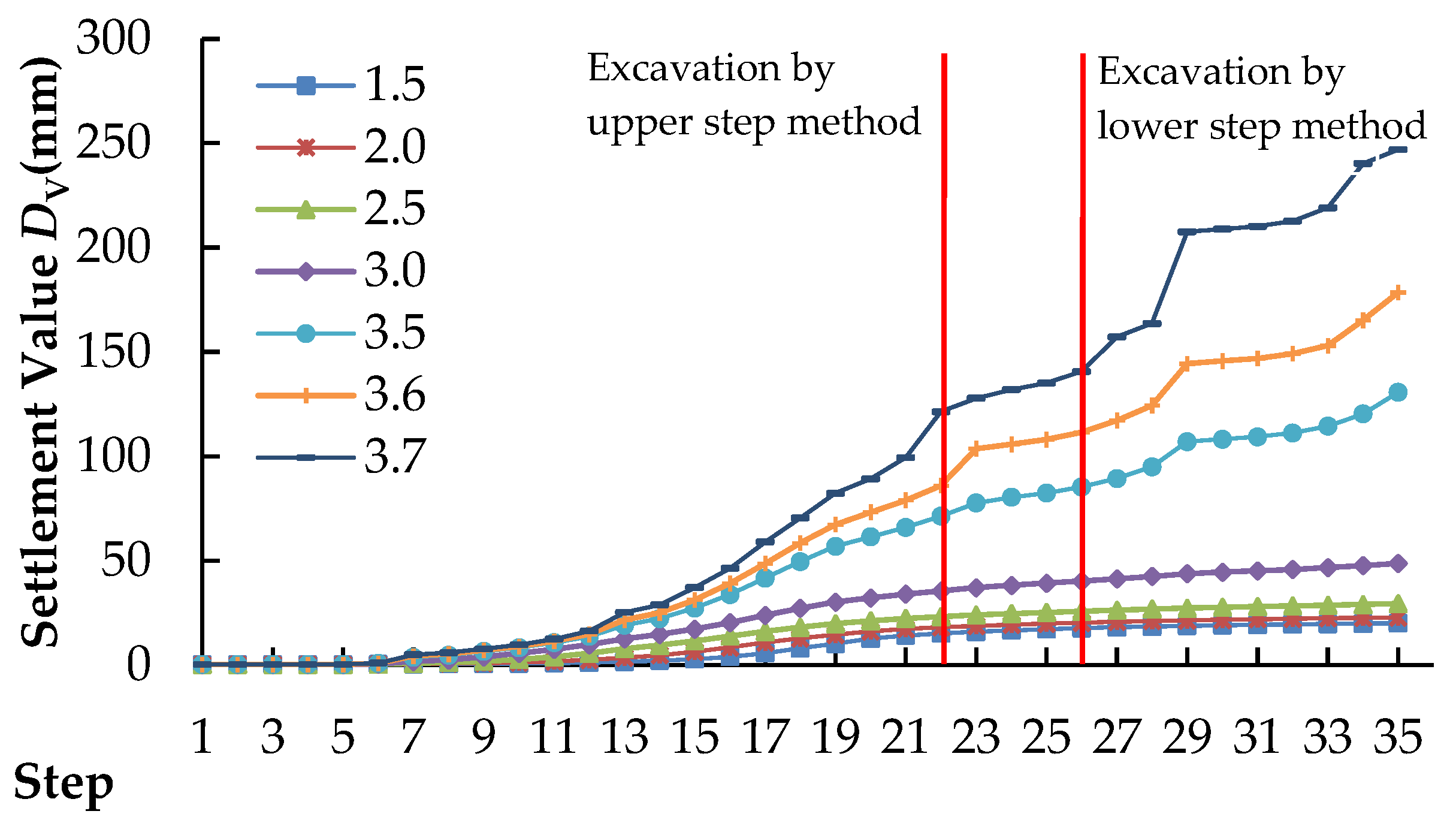
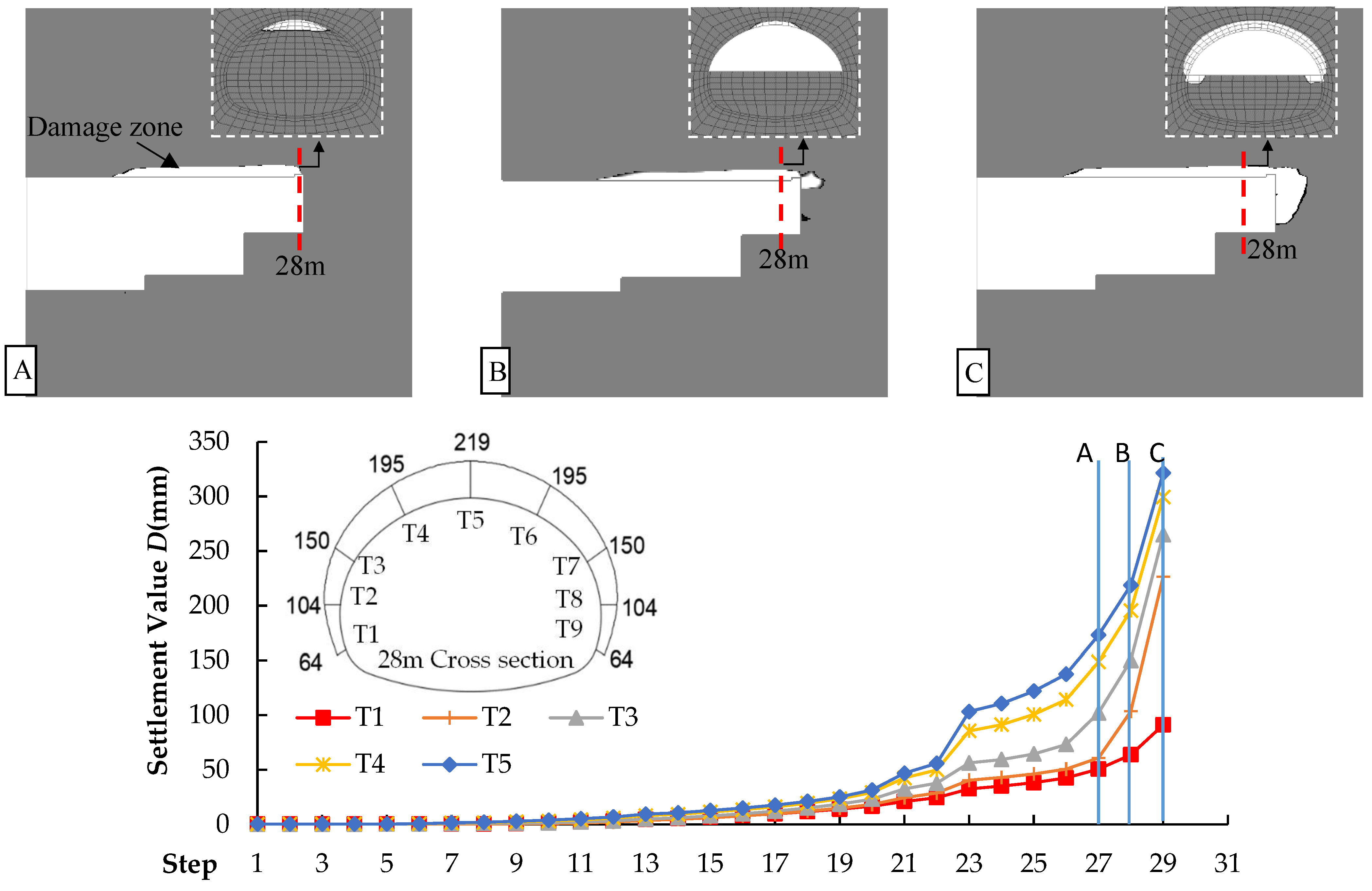
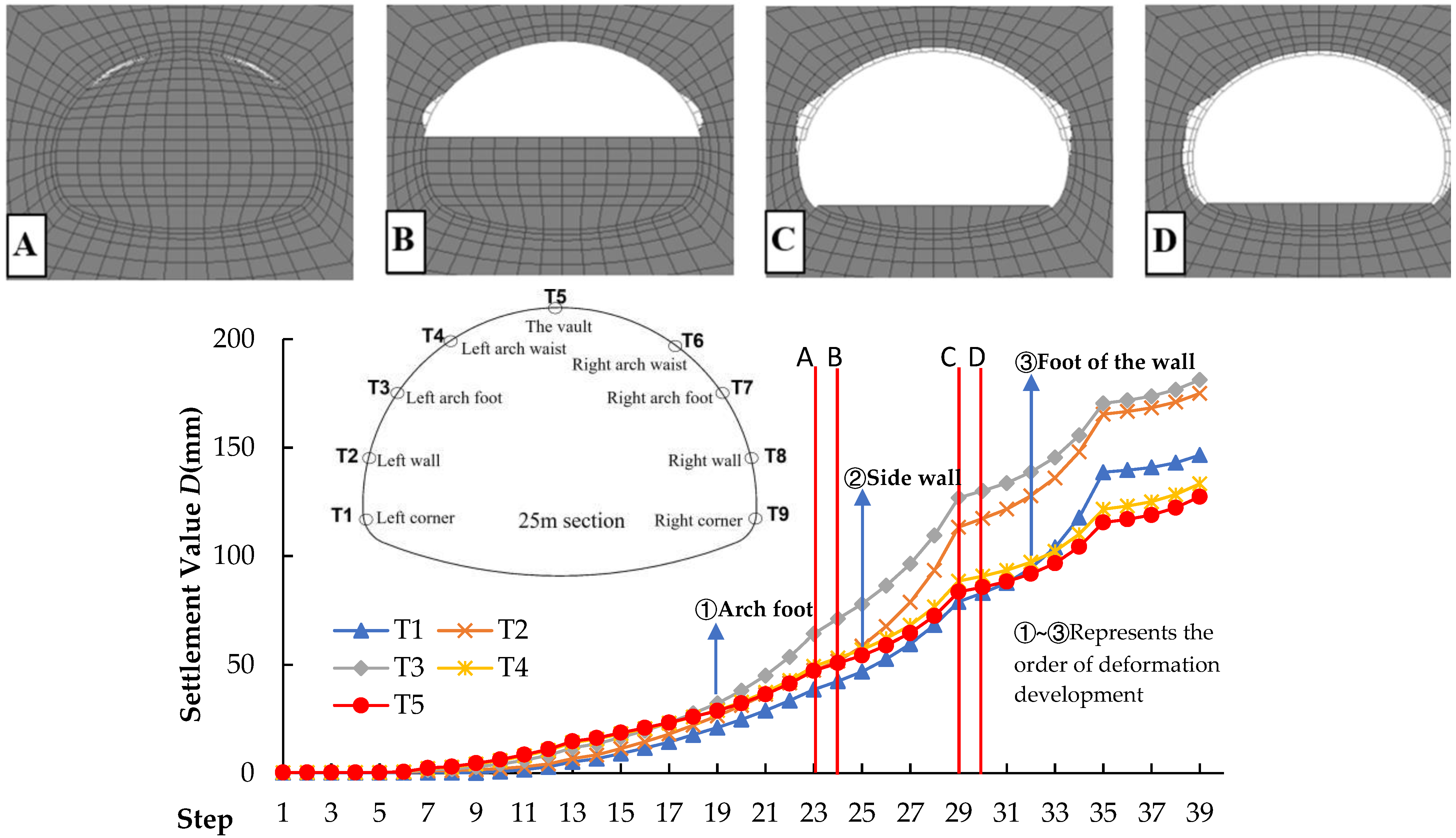

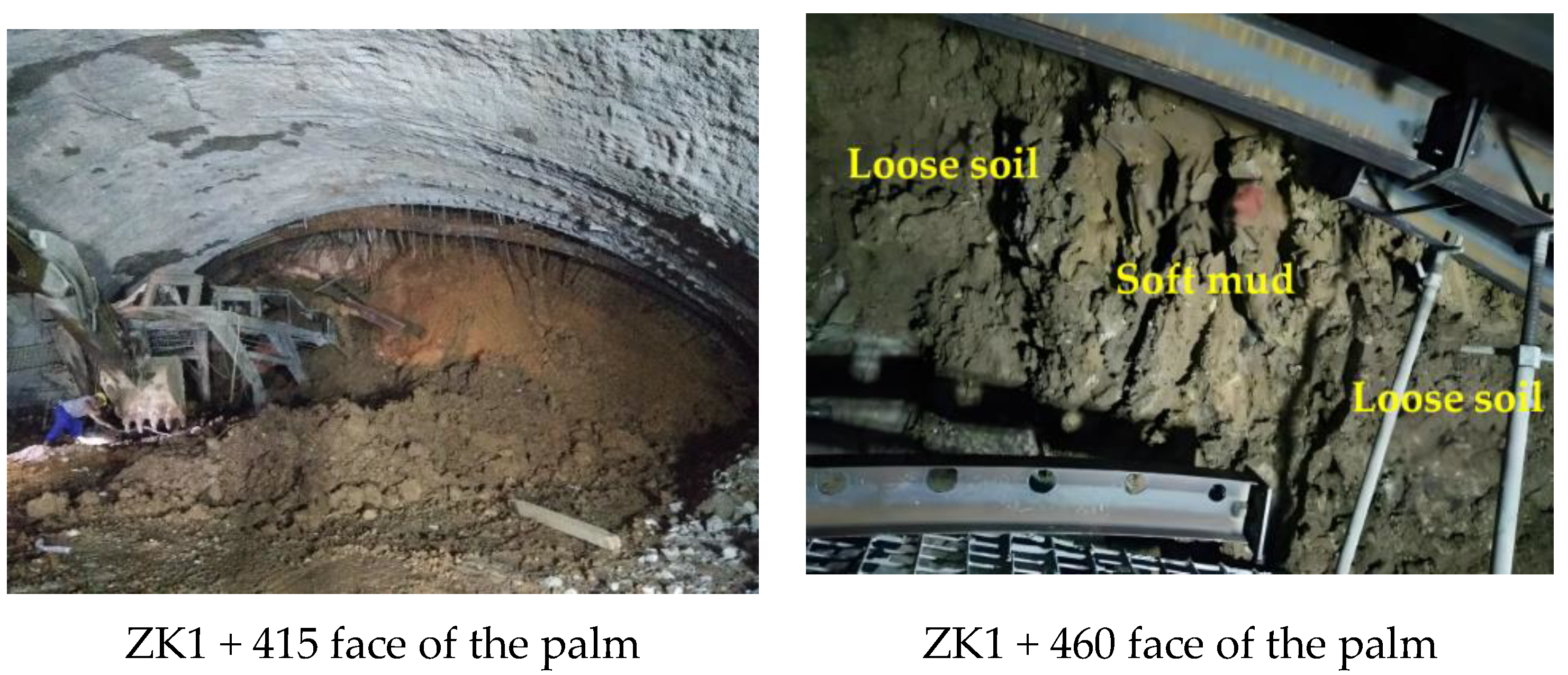
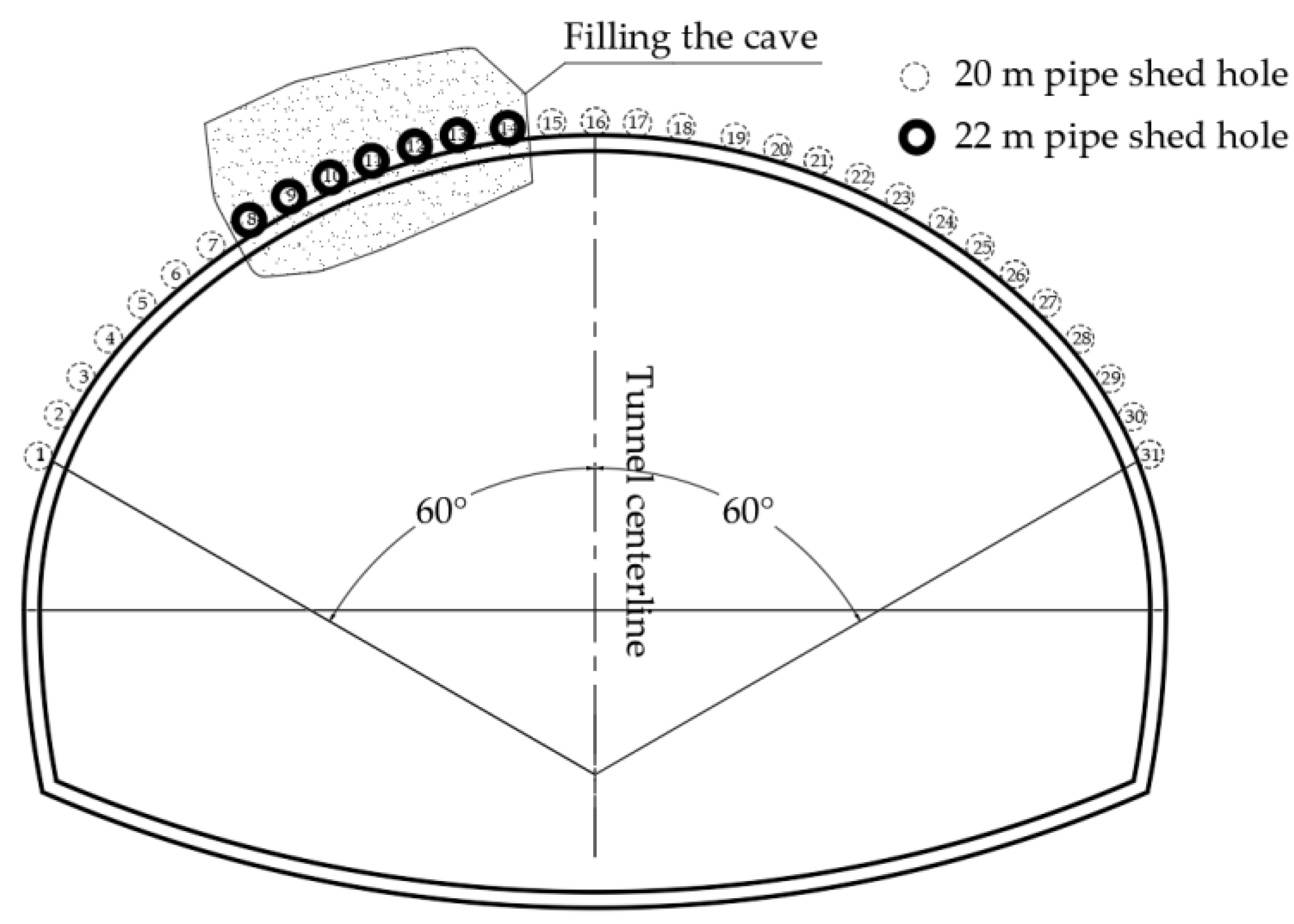
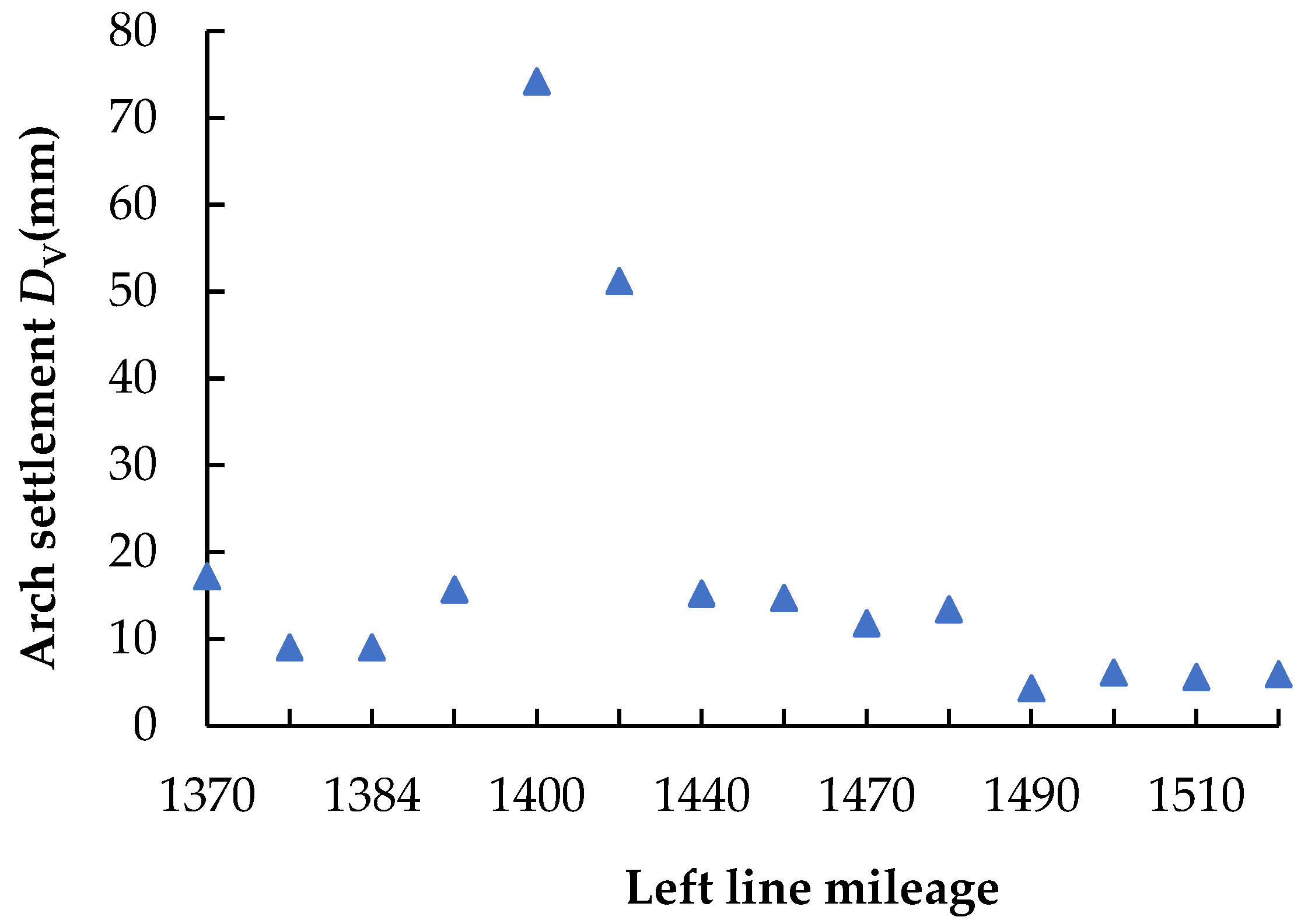
| Material | Gravity γ (kN/m3) | Elastic Modulus E (GPa) | Poisson’s Ratio ν | Force of Cohesion f (MPa) | Friction Angle (°) |
|---|---|---|---|---|---|
| Surrounding rock | 23 | 6.0 | 0.25 | 0.10 | 39 |
| Initial support | 26 | 31.4 | 0.20 | 2.27 | 53 |
| Construction Stage | Reduction Factors | ||||||
|---|---|---|---|---|---|---|---|
| 1.5 | 2.0 | 2.5 | 3.0 | 3.5 | 3.6 | 3.7 | |
| Advanced deformation | 51.1% | 63.5% | 67.3% | 61.9% | 43.5% | 37.6% | 33.3% |
| Excavation of upper steps | 34.7% | 23.3% | 18.3% | 18.6% | 19.5% | 22.8% | 21.4% |
| Excavation of lower steps | 14.3% | 13.2% | 14.4% | 19.6% | 37.1% | 39.6% | 45.3% |
| Project | Surrounding Rock | Supporting Structure | Displacement of Tunnel Face DF (mm) | |||
|---|---|---|---|---|---|---|
| Arch Settlement DV (mm) | Horizontal Convergence DH (mm) | Arch Settlement DV (mm) | Horizontal Convergence DH (mm) | |||
| Reinforcement range (°) | 90 | −155 | 123 | −96 | 62 | −160 |
| 120 | −115 | 117 | −65 | 61 | −145 | |
| 150 | −83 | 85 | −44 | 24 | −133 | |
| 180 | −63 | 59 | −29 | 34 | −119 | |
| Reinforcement length (m) | 15 | −202 | 124 | −112 | 73 | −368 |
| 20 | −161 | 113 | −85 | 67 | −247 | |
| 25 | −160 | 111 | −85 | 68 | −230 | |
| 30 | −159 | 116 | −83 | 65 | −227 | |
| Project | Surrounding Rock | Supporting Structure | Displacement of Tunnel Face DF (mm) | |||
|---|---|---|---|---|---|---|
| Arch Settlement DV (mm) | Horizontal Convergence DH (mm) | Arch Settlement DV (mm) | Horizontal Convergence DH (mm) | |||
| Cycle footage z (m) | 0.5 | −103 | 107 | −58 | 56 | −161 |
| 1.0 | −115 | 117 | −65 | 61 | −145 | |
| 1.5 | −140 | 124 | −90 | 62 | −137 | |
| Step length l (m) | 4.0 | −93 | 99 | −47 | 57 | −157 |
| 6.0 | −115 | 117 | −65 | 61 | −145 | |
| 8.0 | −143 | 133 | −93 | 73 | −134 | |
| Step height h (m) | 4.0 | −98 | 80 | −57 | 20 | −126 |
| 5.0 | −102 | 86 | −58 | 55 | −132 | |
| 6.0 | −115 | 117 | −65 | 61 | −145 | |
| Section | Number/Hole N | Length L (m) |
|---|---|---|
| ZK1 + 358~ZK1 + 373 | 41 | 15 |
| ZK1 + 367~ZK1 + 387 | 42 | 20 |
| ZK1 + 382~ZK1 + 402 | 42 | 20/22 |
| ZK1 + 398~ZK1 + 418 | 42 | 20 |
| ZK1 + 415~ZK1 + 435 | 42 | 20/25 |
| ZK1 + 433~ZK1 + 463 | 42 | 20 |
| ZK1 + 460~ZK1 + 490 | 48 | 20/25 |
| ZK1 + 493~ZK1 + 523 | 37 | 20/25 |
Disclaimer/Publisher’s Note: The statements, opinions and data contained in all publications are solely those of the individual author(s) and contributor(s) and not of MDPI and/or the editor(s). MDPI and/or the editor(s) disclaim responsibility for any injury to people or property resulting from any ideas, methods, instructions or products referred to in the content. |
© 2024 by the authors. Licensee MDPI, Basel, Switzerland. This article is an open access article distributed under the terms and conditions of the Creative Commons Attribution (CC BY) license (https://creativecommons.org/licenses/by/4.0/).
Share and Cite
Wan, F.; Liu, G.; Tang, Y.; Zhang, N.; Xu, D.; Yan, X.; Li, S. Study on the Two-Step Construction Method of Super Large Cross-Section Tunnels Crossing Karst Cave Areas. Appl. Sci. 2024, 14, 4500. https://doi.org/10.3390/app14114500
Wan F, Liu G, Tang Y, Zhang N, Xu D, Yan X, Li S. Study on the Two-Step Construction Method of Super Large Cross-Section Tunnels Crossing Karst Cave Areas. Applied Sciences. 2024; 14(11):4500. https://doi.org/10.3390/app14114500
Chicago/Turabian StyleWan, Fei, Gang Liu, Yifeng Tang, Nian Zhang, Dongliang Xu, Xuehui Yan, and Shuai Li. 2024. "Study on the Two-Step Construction Method of Super Large Cross-Section Tunnels Crossing Karst Cave Areas" Applied Sciences 14, no. 11: 4500. https://doi.org/10.3390/app14114500
APA StyleWan, F., Liu, G., Tang, Y., Zhang, N., Xu, D., Yan, X., & Li, S. (2024). Study on the Two-Step Construction Method of Super Large Cross-Section Tunnels Crossing Karst Cave Areas. Applied Sciences, 14(11), 4500. https://doi.org/10.3390/app14114500





